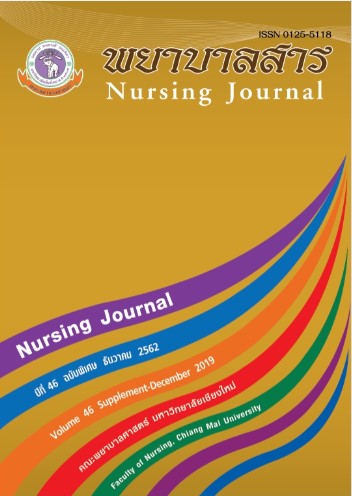ผลของการออกกำลังกายด้วยการเดินแบบนอร์ดิกต่อดัชนีมวลกายและเส้นรอบวงเอว ในผู้สูงอายุที่มีภาวะน้ำหนักเกิน
คำสำคัญ:
การออกกำลังกายด้วยการเดินแบบนอร์ดิก, ผู้สูงอายุที่มีภาวะน้ำหนักเกิน, ดัชนีมวลกาย, เส้นรอบวงเอวบทคัดย่อ
ภาวะน้ำหนักเกินเป็นภาวะที่มีไขมันสะสมอยู่ในร่างกายเกินกว่าปกติเป็นสาเหตุของโรคเรื้อรังที่ก่อให้เกิดภาวะแทรกซ้อนที่เป็นอันตรายต่อชีวิต การออกกำลังกายด้วยการเดินแบบนอร์ดิกอย่างสม่ำเสมอและต่อเนื่องจะช่วยลดไขมันในร่างกายของผู้สูงอายุ การวิจัยเชิงทดลองครั้งนี้มีวัตถุประสงค์เพื่อศึกษาผลของการออกกำลังกายด้วยการเดินแบบนอร์ดิก ต่อค่าดัชนีมวลกายและขนาดเส้นรอบวงเอวในผู้สูงอายุที่มีภาวะน้ำหนักเกิน กลุ่มตัวอย่างเป็นผู้สูงอายุจำนวน 34 รายโดยการสุ่มแบ่งเป็นกลุ่มทดลอง 17 ราย และกลุ่มควบคุม 17 ราย กลุ่มทดลองได้ออกกำลังกายด้วยการเดินแบบนอร์ดิก ครั้งละ 55 นาที สัปดาห์ละ 3 ครั้ง เป็นเวลา 12 สัปดาห์ ส่วนกลุ่มควบคุมออกกำลังกายตามปกติ เครื่องมือที่ใช้ในการดำเนินวิจัยประกอบด้วย แนวปฏิบัติสำหรับการกำลังกายด้วยการเดินแบบนอร์ดิกในผู้สูงอายุ คู่มือการออกกำลังกายด้วยการเดินแบบนอร์ดิกสำหรับผู้สูงอายุที่มีภาวะน้ำหนักเกิน ไม้นอร์ดิก เครื่องวัดอัตราการเต้นหัวใจแบบไร้สาย และเครื่องมือที่ใช้รวบรวมข้อมูลประกอบด้วย แบบบันทึกข้อมูลส่วนบุคคล สายวัด เครื่องชั่งน้ำหนัก วิเคราะห์ข้อมูลโดยใช้สถิติเชิงพรรณนาและทดสอบสมมติฐานโดยใช้สถิติทดสอบค่าที
ผลการวิจัยพบว่า
- ค่าดัชนีมวลกายของผู้สูงอายุภายหลังการออกกำลังกายด้วยการเดินแบบนอร์ดิก มีค่าน้อยกว่าก่อนการออกกำลังกายอย่างมีนัยสำคัญทางสถิติ (p < .01)
- ค่าดัชนีมวลกายของกลุ่มที่ออกกำลังกายด้วยการเดินแบบนอร์ดิกมีค่าน้อยกว่ากลุ่มควบคุมที่ไม่ได้ออกกำลังกายด้วยการเดินแบบนอร์ดิกอย่างมีนัยสำคัญทางสถิติ (p < .05)
- ขนาดเส้นรอบวงเอวของผู้สูงอายุภายหลังการออกกำลังกายด้วยการเดินแบบนอร์ดิก มีค่าน้อยกว่าก่อนการออกกำลังกายอย่างมีนัยสำคัญทางสถิติ (p < .001)
- ขนาดเส้นรอบวงเอวของกลุ่มที่ออกกำลังกายด้วยการเดินแบบนอร์ดิกมีค่าน้อยกว่ากลุ่มควบคุมที่ไม่ได้ออกกำลังกายด้วยการเดินแบบนอร์ดิกอย่างมีนัยสำคัญทางสถิติ (p < .01)
References
Prescription (8thed.). Philadelphia: Lippincott Williams & Wilkins.
Chatchawarat L, Lasuka D and Khampolsiri T. (2014). Review of periscope: The effect of Nordic
Walking exercise on obese elderly. Population health: Cross-cultural nursing and health care
Quality. Faculty of nursing. ChiangMai University. (In Thai)
Doungtipsirikul S, Sirisamut T, Tuntipisitkul K, Engsrisawang L and Terawattananon Y. (2013). Report
Of the 2013: Thai Health Status Survey under the Health Promotion Program for the Elderly and the Disabled. Bangkok: Watcharin PP. (In Thai)
Elisabeth, M. H., Basdevant, A., Finer, N. & Roman, G. (2012). Prevalence, Pathophysiology, Health Consequences and Treatment Options of Obesity in the Elderly: A Guideline obesity facts.5, 460–483. doi:10.1159/000341193
Figard, F.H., Fabre, N., Leonardi, A. & Schena, F. (2011). Efficacy of Nordic Walking in Obesity
Management. International journal of sports medicine. 32(6), 407-414.
Fritz T, K., Caidahl, M., Osler, Stenson C.G.O, Zierath, J.R., & Wandell, P. (2011).
Effects of Nordic walking on health-related quality of life in overweight individuals with Type 2 diabetes mellitus, impaired or normal glucose tolerance. Diabetic Medicine, 1363-1372. doi:10.1111/j.1464-5491.2011.03348.x.
Geriatric Medicine Thailand.(2004). A guide to assessing nutritional status in the elderly. Depertment
of medical services, Ministry of public health (In Thai)
Han, T.S., Tajar, A. & Lean, M.E.J. (2011). Obesity and weight management in the elderly.
BritishMedical Bulletin; 97, 169–196. doi:10.1093/bmb/ldr002
Janssen. I. (2007). Morbidity and mortality risk associatedwith an overweight BMI in older men and women. Obesity, 15(7), 1827–1840.
John P. P. (2008). Nordic Walking.University ofWisconcin. Retrived from
http://curriculum.dpsk12.org/physical_education/prof_dev/archives/NORDIC_WALKIN G_11- 3- 08.pdf
Mathus - Vliegen, E. M. H., Basdevant, A., Finer, N., Hainer, V., Hauner, H., Micic, D., Zahorska- Markiewicz, B. (2012). Prevalence, Pathophysiology, Health Consequences and Treatment Options of Obesity in the Elderly: A Guideline. Obesity Facts, 5(3), 460-483.
Ogden, C. L., Carroll, M. D., Kit, B. K., & Flegal, K. M. (2013). Prevalence of obesity among adults: United States, 2011-2012. NCHS Data Brief(131), 1-8.
Rungroj Thavorn.(2011). Indicator and range of values that indicate obesity.
Naresuan University (In Thai)
Schiffer, T., Knicker, A., Momtanarella, M. &Striider H.K. (2011). Mechanical and physiological effects of varying pole weights during Nordic walking compared to walking .Eur J Appl Physio, 111, 1121-1126. doi:10.1007/s00421-010-1739-5
Research. 7, 1-7.doi:10.1016/j.anr.2012.11.001
Tschentscher, M., Niederseer, D. &Niebauer, J. (2013). Health Benefits of Nordic Walking A
Systematic Review. American Journal of Preventive Medicine, 44(1), 76-84.doi:
10.1016/j.amepre.2012.09.043
Villareal, D.T., Apovian, C. M., Kushner, R.F. & Klein, S. (2014). Obesity in older adults. Technical review and position statement of the American Society for Nutrition and NAASO, The Obesity Society. The American journal of clinical nutrition, 925-926.
World Health Organization. (2011). Waist Circumference and Waist–Hip Ratio. Report of a WHO Expert Consultation. Geneva
Downloads
เผยแพร่แล้ว
How to Cite
ฉบับ
บท
License
บทความที่ได้รับการตีพิมพ์เป็นลิขสิทธิ์ของวารสารพยาบาลสาร
ข้อความที่ปรากฏในบทความแต่ละเรื่องในวารสารวิชาการเล่มนี้เป็นความคิดเห็นส่วนตัวของผู้เขียนแต่ละท่านไม่เกี่ยวข้องกับมหาวิทยาลัยเชียงใหม่ และคณาจารย์ท่านอื่นๆในมหาวิทยาลัยฯ แต่อย่างใด ความรับผิดชอบองค์ประกอบทั้งหมดของบทความแต่ละเรื่องเป็นของผู้เขียนแต่ละท่าน หากมีความผิดพลาดใด ๆ ผู้เขียนแต่ละท่านจะรับผิดชอบบทความของตนเองแต่ผู้เดียว





